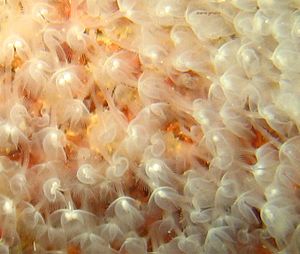Brachiozoa facts for kids
Quick facts for kids Brachiozoa |
|
|---|---|
 |
|
| A colony of the phoronid Phoronis hippocrepis in shallow water at the coast of Italy. | |
| Scientific classification |
|
| Kingdom: | Animalia |
| Clade: | Lophophorata |
| Clade: | Brachiozoa Cavalier-Smith 1998 |
Brachiozoa is a special group of animals that are part of a larger supergroup called Lophotrochozoa. This group includes two main types of marine animals: Phoronida (horseshoe worms) and Brachiopoda (lamp shells). These animals might look very different, but scientists group them together because they share some important features, especially how they develop and a unique feeding organ called a lophophore.
Contents
What are Brachiozoa?
Brachiozoa are fascinating marine creatures. They are known for having a special feeding structure called a lophophore. This lophophore is a crown of tentacles that helps them filter tiny food particles from the water. Think of it like a natural sieve! Both phoronids and brachiopods use this amazing tool to eat.
The Lophophore: A Special Feeding Tool
The lophophore is a circular or horseshoe-shaped organ. It has many hollow tentacles covered in tiny hairs called cilia. These cilia beat rhythmically, creating currents that draw water and food towards the animal's mouth. It's a very efficient way for them to get nutrients from their watery homes.
Phoronida: The Horseshoe Worms
Phoronida are a small group of worm-like animals. They are often called "horseshoe worms" because their lophophore is shaped like a horseshoe. These worms live in tubes they build themselves. They usually live in shallow ocean waters. You might find them attached to rocks or shells.
Where Phoronids Live
Phoronids are found in oceans all over the world. They prefer coastal areas where they can attach to hard surfaces. They build their tubes out of chitin, a tough material. These tubes protect them from predators. When they want to feed, they extend their lophophore out of the tube. If danger approaches, they quickly pull it back inside.
Brachiopoda: The Lamp Shells
Brachiopods are marine animals that look a bit like clams. However, they are not related to clams at all! Clams are molluscs, but brachiopods are a completely different group. They have two shells, just like clams. But their shells are different in how they are shaped and how they open. Brachiopods have a top and bottom shell. Clams have a left and right shell.
Brachiopod Shells and Lifestyle
Brachiopods are often called "lamp shells." This is because some types look like ancient Roman oil lamps. Most brachiopods attach themselves to the seafloor using a stalk called a pedicle. This stalk helps them stay in place. They use their lophophore to filter food from the water. Brachiopods have been around for a very long time. Their fossils are common in ancient rocks.
Brachiopods: Living Fossils
Brachiopods are sometimes called "living fossils." This is because many species alive today look very similar to their ancestors from hundreds of millions of years ago. They were very common in ancient oceans. Today, there are fewer types of brachiopods. But they are still an important part of marine ecosystems.
Why are Brachiozoa Grouped Together?
Scientists group Phoronida and Brachiopoda into Brachiozoa because of their shared features. The most important shared feature is the lophophore. They also have similar ways their bodies are organized. Studying these groups helps scientists understand how different animal groups are related. It also helps us learn about the history of life on Earth.
See also
 In Spanish: Brachiozoa para niños
In Spanish: Brachiozoa para niños

